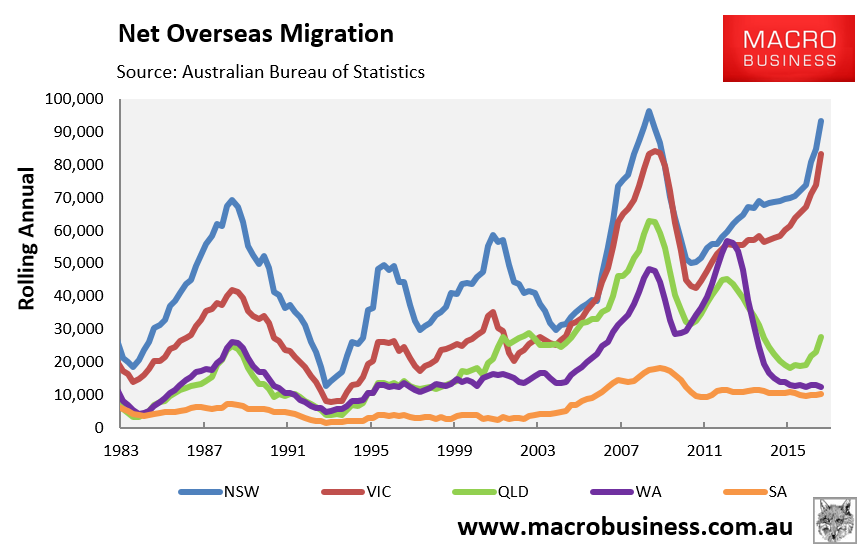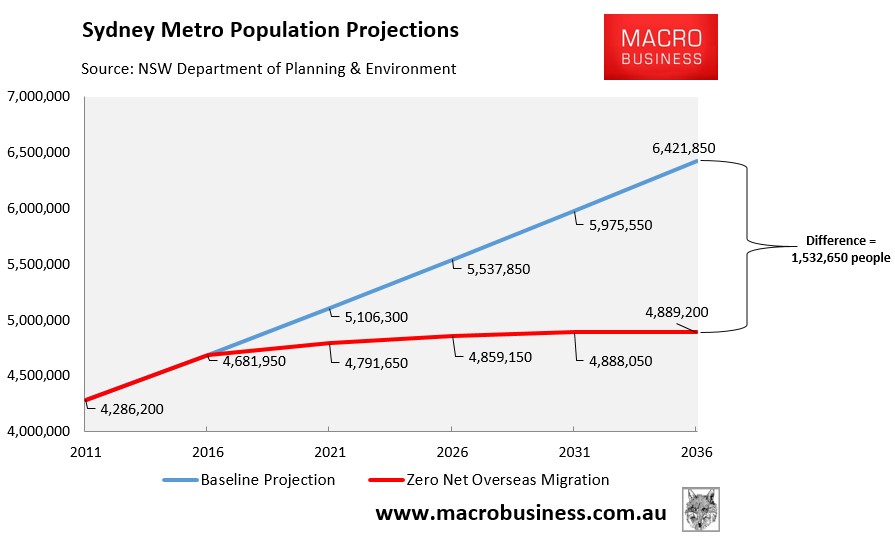I have noted previously that one of the key reasons why Australia’s high population growth (immigration) is lowering the living standards of existing residents is because of the strain that it places on infrastructure, which inevitably leads to more congestion on roads, public transport, as well as more expensive housing.
Basic math (and commonsense) suggests that if you double the nation’s population, you need to at least double the stock of infrastructure to ensure that living standards are not eroded (other things equal).
In practice, however, the solution is not that simple. In already built-up cities like Sydney, which also happen to be the major magnet for new migrants (see next chart), the cost of retrofitting new infrastructure to accommodate greater population densities can become prohibitively expensive because of the need for land buy-backs, tunnelling, as well as disruptions to existing infrastructure.

In the case of Sydney, we have already witnessed these diseconomies of scale with the North West Rail Link, which is expected to cost an astounding $8.3 billion, as well as with the WestConnex road project – the $17 billion 33 kilometre motorway under construction that is more expensive per kilometre than the Chanel Tunnel.
Not only are these projects hideously expensive, but they often create major indigestion for Sydney residents during the construction phase. Moreover, in the case of WestConnex, existing free public roads like the state-owned M4 (that have already been paid off) will be tolled to help fund the project, raising costs for residents.
In fact, the cost of such projects is so great that the Grattan Institute estimated that “unprecedented infrastructure spending by states and territories” since the escalation of population growth from 2004 is “largely responsible for a $106 billion decline in their finances since 2006“, and that “after a threefold increase in capital spending over the last 10 years, states are paying 3 per cent more of their revenues in interest and depreciation”.
Today, the hideous complexity and costs associated with the WestConnex road project have been further uncovered by The SMH, which reports that the private sector has steered clear from bidding to build the interchange at Rozelle in Sydney’s inner west because of the complexity:
The government insists the setback in finding a builder of the underground spaghetti junction will not alter its plans for construction of the entire 33-kilometre toll road, to be completed by 2023, or the sale of a 51 per cent stake in the project next year…
The underground interchange at Rozelle will be complex to build because it will be up to 65 metres deep, and comprise three levels of tunnels and scores of entrances and exits, including a link to the proposed but as yet unfunded Western Harbour Tunnel.
The Greens’ transport spokeswoman Mehreen Faruqi said she was not surprised companies were hesitant to bid for the interchange, because it was “bizarre and virtually unbuildable” under its present design…
$17 billion. Three levels of deep tunnels. These are the types of expensive and complicated projects required to retrofit already built-out cities like Sydney to cater for rampant population growth. And the costs are borne by existing residents – either through higher taxes or expensive tolls.
Let’s get real for a moment: it is the federal government’s mass immigration program that is primarily responsible for the 87,000 people per year projected increase in Sydney’s population to 6.4 million over the next 20-years, which would effectively add another Perth to the city’s population:

Blind Freddy can see that running a high immigration program requires massive investment and costs a lot, and that these costs are made worse by the diseconomies of scale discussed above. The huge infrastructure costs also force unpopular asset sales, increased debt borrowings and austerity – none of which is a desirable outcome.
Clearly, the most obvious and least cost policy solution to mitigate Sydney’s infrastructure woes is to significantly dial back Australia’s immigration program and forestall the need for costly new infrastructure projects in the first place. Because under current mass immigration settings, expensive solutions like WestConnex will be required over and over again as rapid population growth continually outstrips the supply of transport infrastructure.

